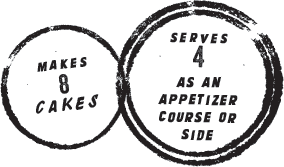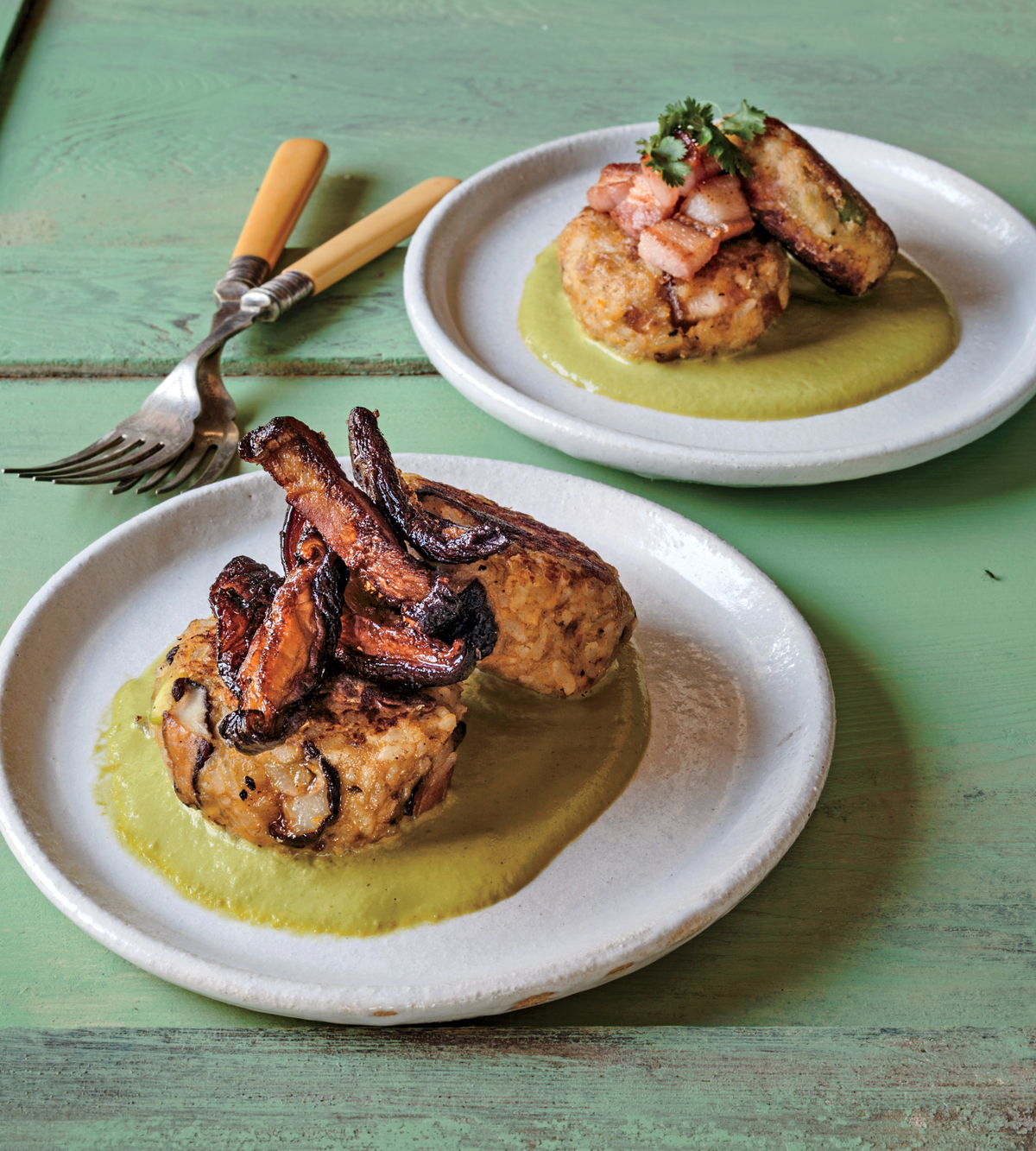
Tacacho con Salsa Verde
Plantain Rice Cakes with Jalapeño-Huacatay Sauce
Tacachos are patties made from plantains smashed between grinding stones and flecked with small pieces of fried pork. Like the tacu tacu on page 211, this dish is rooted in African traditions. It is especially popular in villages in the Amazon, where plantains are widely available.
Traditionally, tacacho is served as a fritterlike snack. I like a more savory version, so I fold in leftover rice and sometimes even beans like chickpeas, or I’ll turn it into a vegetarian dish by omitting the bacon and using sautéed mushrooms instead.
The plantains are best when they are very ripe and the skin has blackened on the grill, but you can sear them (unpeeled) directly over the flame of a gas stove, like eggplants (see page 186), for a quick side dish. As with bananas, you can put them in a paper sack to speed up the ripening process.
- 2 ripe medium plantains, unpeeled
- 6 to 8 slices thick, meaty, smoky bacon, coarsely chopped, or 1 portobello mushroom cap, halved and cut into ½-inch-thick strips plus 1½ to 2 cups sliced mushrooms
- Olive oil
- 2 tablespoons Salsa Madre (page 196)
- About 2 cups cooked white or brown rice (not sushi rice), or more as needed
- Kosher salt and freshly ground black pepper
- Canola or other vegetable oil
- Jalapeño-Huacatay Sauce (recipe)
1 Grill or sear the plantains. To grill, prepare a grill for medium-high-heat cooking. Put the plantains on the grill or directly on a stovetop gas range over high heat (on the stovetop, the flames should kiss the flesh; see charring eggplant, page 186). Sear the plantains until the skin blackens all over and begins to split, about 5 minutes on the stovetop or a few minutes longer on the grill. Flip the plantains with tongs occasionally so they blacken evenly. Let the plantains cool slightly, peel, and smash them with a potato masher or in a large mortar and pestle (I use a Japanese grinding stone) until the flesh has broken down but is still chunky. You should have about 1 cup (refrigerate or freeze any excess for later).
2 Preheat the oven to 250°F. Line a baking sheet with a few layers of paper towels. To make the bacon version, sauté the bacon in a large sauté pan over medium-high heat until golden brown, 4 to 5 minutes. Pour off the rendered fat into a small bowl, leaving a thin layer of fat in the pan. To make the mushroom version, in a large sauté pan, heat about 2 tablespoons of olive oil over medium-high heat until hot, about 2 minutes. Add the sliced portobello cap and sauté, stirring often, until the pieces are golden brown on all sides and tender, about 6 minutes. (Break one open if needed to make sure it is fully cooked.) Use tongs to transfer the portobellos to an ovensafe plate. If the pan looks dry, add another tablespoon of olive oil, heat the oil for about a minute, and add the sliced mushrooms. Sauté, stirring often, until the slices are golden brown on all sides and tender, 4 to 5 minutes. Transfer the sliced mushrooms to a small bowl.
3 Return the pan to the heat, add the salsa madre, and sauté, stirring continuously, until it smells aromatic, about 30 seconds. Add the rice, scrape up any brown bits, and transfer to a medium bowl.
4 Add the smashed plantains, about half the bacon or all the sliced mushrooms (whichever you are using; if mushrooms, save the portobello strips for garnish), and mix well to combine. If the mixture feels wet, add a little more rice. Taste and season the mixture with salt and pepper if needed. Lightly oil your hands with the bacon fat or vegetable oil and shape the mixture firmly into patties the shape of small hamburgers.
5 Heat a few tablespoons of oil in a skillet (preferably nonstick) over medium-high heat for 2 to 3 minutes, until very hot. Fry the patties a few at a time (do not overcrowd the pan) and cook until they are golden brown, about 2 minutes per side, flipping once with tongs halfway through the cooking time. Transfer the patties to the lined baking sheet. If not serving immediately, put the baking sheet in the oven while you continue to fry the remaining patties the same way.
6 To serve, spoon about ¼ cup of the huacatay sauce on the bottom of each of four small plates. Place 2 patties on each plate and arrange a few pieces of bacon or portobello mushroom caps on top of each. Or pile the cakes onto a large platter, sprinkle the bacon or portobellos on top, and serve the huacatay sauce in a bowl alongside, for dipping. Serve inmediatamente.

Jalapeño-Huacatay Sauce
Makes about 1 cup
This is one of my favorite sauces. The funny thing is, other than a few of the ingredients like ají amarillo paste and huacatay, an herb that tastes almost like a mix between basil and mint, it’s not even all that Peruvian. It took me a while to figure out what people were talking about when they said they loved the “green sauce” they had at Peruvian restaurants in the United States that is served on top of all sorts of dishes, from choclo corn to roast chicken. We don’t really have such a thing, other than some of the seco sauces we use on stews like seco de cordero (braised lamb with seco sauce, page 150). That is a cilantro, ají pepper, and sometimes huacatay-based braising sauce, yes, but it’s traditionally only served with certain dishes, and everything cooks down together with the meat or poultry.
When I finally tried this mysterious Peruvian-American “green sauce,” I liked it so much, I decided to make my own. Other than the tacacho, I mix the sauce into rice, quinoa, or other grains, or spoon it on top of corn or potatoes. Whatever you serve it on is even better topped with more queso fresco, or, my favorite with this sauce, a tangy goat cheese. To make a vegan version of the sauce, use tofu instead of cheese.
- 1 to 2 medium jalapeños, seeded and deveined
- 1 medium bunch fresh cilantro, leaves and top two-thirds of stems
- 1 teaspoon pureed garlic (see page 37) or finely minced garlic
- 1½ tablespoons ají amarillo paste, store-bought or homemade (see page 34)
- ¼ cup crumbled goat cheese, queso fresco, or tofu
- 5 tablespoons red wine vinegar
- 2 tablespoons packed fresh huacatay leaves, or 1 tablespoon frozen huacatay, thawed
- ½ cup extra-virgin olive oil
- 1 teaspoon kosher salt, or more to taste
Puree all of the ingredients in a blender until smooth. Season with more salt and add another jalapeño, if you like. Cover and refrigerate the sauce for up to 5 days.